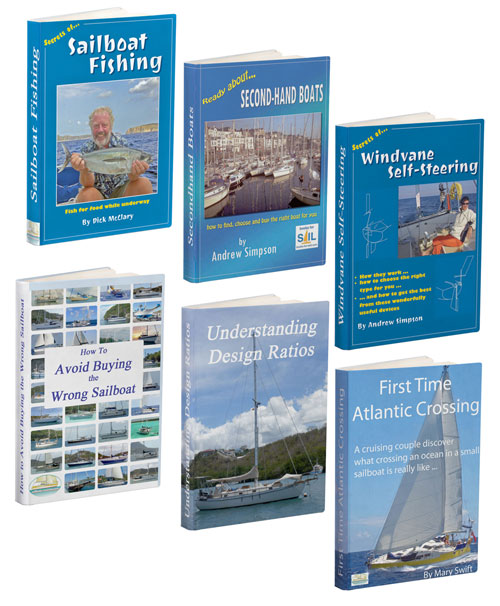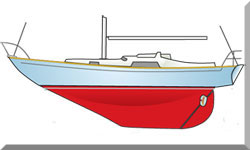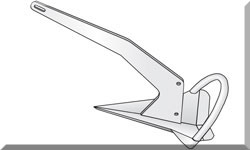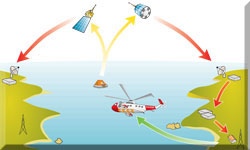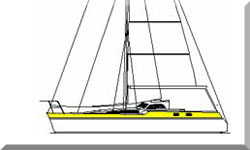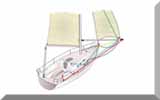- Home
- Bluewater Sailing
- Offshore Passage Plan
Crafting Your Offshore Passage Plan & Navigating SOLAS
In a Nutshell...
Crafting an Offshore Passage Plan isn't just about drawing a line on a chart; it’s an essential, four-step systematic process—Appraisal, Planning, Execution, and Monitoring—that ensures safety, efficiency, and environmental compliance for any blue-water voyage. For the experienced sailor, this plan is the critical bridge between shore-based preparation and safe execution at sea, especially for ocean crossings where self-reliance is paramount. Adhering to the principles outlined in SOLAS Chapter V, while tailored for recreational yachts, is a non-negotiable part of your seamanship, requiring thorough preparation using all available resources—from paper charts and tide tables to modern GRIB files and satellite communication.
Table of Contents
- Why a Solid Passage Plan is Your Most Crucial Piece of Gear
- The Four Pillars of Passage Planning
- Equipment & Technology: Modern Blue-Water Essentials
- Managing the Human Factor: Watchkeeping & Fatigue
- Contingency Beyond the Course: Preparing for Major System Failure
- A Comprehensive Passage Plan Template
- Environmental & Regulatory Checklist
- Summing Up
- FAQs: Offshore Passage Planning
Why a Solid Passage Plan is Your Most Crucial Piece of Gear
If you’re a seasoned sailor you already know that a comprehensive Offshore Passage Plan isn't a formality; it’s the bedrock of a successful voyage. Out on the ocean, your plan is more than just a course to steer; it’s a living document that allows you to confidently manage the inevitable curveballs the sea throws at you, from an unexpected low-pressure system to a last-minute course alteration to avoid a busy shipping lane.
A strong plan doesn't just keep you on course; it allows you to anticipate and mitigate risks before they become emergencies. For us ocean sailors, the entire process can be broken down into four essential, logical steps that naturally flow into one another, making even the most complex international journey easier to manage and, crucially, safer. You shouldn’t consider casting off until these four pillars are firmly in place.
The Four Pillars of Passage Planning
This diagram visually represents the iterative nature of robust passage planning, highlighting how monitoring feeds back into appraisal for continuous adaptation.
 Figure 1: The Passage Planning Cycle – A continuous feedback loop for safe navigation.
Figure 1: The Passage Planning Cycle – A continuous feedback loop for safe navigation.1. Appraisal: Gathering Your Intelligence
The first, and perhaps most vital, stage is gathering all the relevant information—your maritime intelligence—before you even think about setting sail. This phase is all about due diligence and ensuring you've got the full picture of the operating environment.
- Weather Forecasts: Check reliable sources. Don’t just rely on one phone app; use a suite of tools. This means downloading GRIB files via satellite link or SSB for the full duration of your passage, cross-referencing these with professional marine forecasts, and understanding the synoptic situation. You need to know when that front’s going to arrive, not just the wind speed today.
- Tidal Streams & Currents: For coastal legs or negotiating major capes, understand the timing of tides and the velocity of currents. The difference between a fair tide and a foul tide could add days to an ocean passage. For example, planning your departure from the Solent must be timed perfectly to catch the stream down the Channel.
- Navigational Hazards: Study the charts (both electronic and paper) meticulously. Look out for restricted areas, submarine cables, unlit platforms, and wrecks. Pay particular attention to Traffic Separation Schemes (TSS) and know exactly where and how you’re going to cross them before you’re in the middle of a stream of tankers.
- Route Information & Local Knowledge: Beyond the charts, seek out recent cruising guides and, critically, talk to local sailors. Their unique insights—like a reliable anchorage in a strong easterly or a known current anomaly—can prove invaluable when your systems fail.
This comprehensive data-gathering process builds the strong foundation upon which your flexible sailing strategy will rest.
2. Planning: Mapping the Strategy
With all your intelligence gathered, the next step is to translate that data into a safe, efficient, and adaptable route on your chart.
- Identify Contingency Points: Mark safe havens, accessible anchorages, or designated storm avoidance areas along your proposed route. These are your 'outs' if conditions deteriorate.
- Plotting Multiple Courses: Rarely is the shortest route the best. Consider three main options:
- Shortest distance (Rhumb Line): The most direct path.
- Weather-Optimised Route: A course that uses wind and wave direction to your advantage, often determined by weather routing software. This is critical on ocean passages to avoid major storm centres.
- Contingency Route: A pre-planned course to a nearby alternative port in case of a major gear failure or crew emergency.
- Calculating Safety Margins: Ensure you plot your course well clear of dangers. A distance that feels safe in an afternoon motorboat trip is entirely insufficient when crossing an ocean in heavy weather. Use the four-step course planning method (C-A-P-T): Course, Alarms, Performance, Traffic. Always plan to sail in a manner that minimises risk.
Your plan must be inherently flexible. It’s a guide, not a prison sentence. Sketching your course in a way that allows for easy, pre-calculated adjustment is key to good seamanship.
3. Execution: Putting the Plan to Work
This is where the rubber meets the road—or, rather, the keel meets the water. It’s about setting sail and sticking to the strategic route you’ve meticulously mapped out.
When you weigh anchor, you must:
- Commit to the Course: Trust your initial planning. Your plan was made in a calm, rational environment. Don't be tempted to make major, spur-of-the-moment deviations unless absolutely necessary.
- Maintain Situational Awareness: While the plan is your guide, the sea is dynamic. Continuously observe the weather, the sea state, and other traffic. As an experienced ocean sailor, you know that the best weather forecast is the one you make yourself by looking out the hatch. Be ready to activate one of your pre-planned contingency routes if conditions shift dramatically.
- Integrate Experience: Execution is the step that combines careful planning with your accumulated experience and instinct. A sudden change in the cloud formation, a specific shift in the wind’s quality, or an uneasy feeling about the boat's motion are all valid inputs that should prompt a review of the plan.
4. Monitoring: Continuous Review & Adjustment
A passage plan is useless if it’s not continually assessed against reality. Monitoring is the ongoing process of checking, logging, and updating.
- Regular Position Checks: Use your GPS, log readings, and, yes, even celestial fixes if conditions allow, to verify your position. Compare your actual progress against your estimated time of arrival (ETA) at key waypoints.
- Log Everything: Maintain a detailed Ship’s Log. This includes hourly position checks, weather observations, sail changes, engine hours, and any significant incidents. A well-kept log isn't just a record; it’s a critical legal document and a trust signal for all onboard.
- Weather Monitoring: Continuously update your weather forecast. On an extended ocean passage, you should be downloading fresh GRIB files at least twice daily. A small change in the forecast can demand a significant course alteration days in advance.
- Shore Contact & Accountability: Establishing a clear communication plan with a reliable shore-based contact (the person who holds your float plan) is an essential safety feature, adding a layer of security to your journey.
Equipment & Technology: Modern Blue-Water Essential.
| Equipment & System | Role in Passage Planning | Expertise Insight |
|---|---|---|
| Electronic Chart Systems (ECS) | Primary real-time navigation and plotting. Essential for anti-collision. | Requires redundancy—always have a second, independent system (e.g., tablet/laptop with different software). Never rely solely on a single plotter. |
| Satellite Communication | Downloading GRIB files, receiving official forecasts, and vital shore-based contact. | Invest in a reliable system (e.g., IridiumGO!) and practice sending and receiving data before departure. Weather routing depends on this. |
| AIS (Automatic Identification System) | Collision avoidance, particularly in coastal areas and TSS. | Use the CPA (Closest Point of Approach) alarm function aggressively. Don't just watch the screen; use the bearing and range to visually confirm the target. |
| Paper Charts | Critical backup for system failure (fire, power loss, software crash). | Your plan must be plotted on paper first, or at least immediately replicated there. You can’t navigate a complex TSS using a phone screen and a protractor. |
The SOLAS Chapter V Requirement: Navigating the Law
For the experienced sailor, understanding the application of SOLAS (Safety of Life at Sea) Chapter V, Regulation 34 is essential, even on a recreational vessel. This regulation under the International Convention for the Safety of Life at Sea clearly emphasises the importance of a meticulously planned passage for all vessels proceeding to sea.
The spirit of the regulation, which concerns safety, efficient navigation, and environmental protection, certainly applies to a recreational yacht, especially on an international or blue-water voyage. While smaller vessels have some flexibility, the principles of the regulation are non-negotiable good seamanship:
A passage plan must take into account all relevant information, including the vessel's capabilities, navigational hazards, weather, and tides.
The requirement highlights the need for continuous monitoring—a point often overlooked by weekend sailors. This means the plan is a continuous cycle of checking your position, assessing the forecast, and being ready to adjust your course in the face of changing circumstances. For us, compliance isn't a bureaucratic headache; it’s confirmation that we’ve carried out a professional and thorough preparation, which ultimately enhances our trustworthiness as master of the vessel.
Managing the Human Factor: Watchkeeping & Fatigue
On long offshore passages, the most sophisticated plan can be undermined by a simple thing: fatigue. For the experienced sailor, managing the human factor is as crucial as managing the weather. Crew burnout, poor decision-making, and errors during watch handovers are prime causes of incidents at sea. Your passage plan must therefore include a rigorous, sustainable watchkeeping protocol.
Creating an Effective Watch Rota
The classic watch system is three hours on/six hours off (or four on/four off), but for long-distance cruising, the focus should be on maximising deep, restorative sleep:
- The 3/6 Model: This schedule (e.g., 21:00 to 00:00, then off until 06:00) works well for smaller crews, ensuring each member gets one long block of uninterrupted sleep daily. Crucially, rotate the starting time daily (a 'dog watch' adjustment) to avoid any one person always getting the undesirable midnight-to-dawn slot.
- Single-Handed Protocol: If you’re sailing solo or with minimal crew, implement a schedule of "power naps" (20-30 minutes) at regular, frequent intervals (e.g., every two hours) during the day, alongside a longer, protected period of sleep (4-5 hours) at night. Don't ever push past the point of exhaustion, especially in high-traffic or foul weather conditions.
Mastering these human factors is a key component of overall preparation. For a comprehensive overview of everything required before you cast off the lines, consult The Ultimate Blue Water Sailing Guide: Preparation & Seamanship for the Ocean.
The Critical Watch Handover
This is when many small errors occur. A comprehensive handover ensures continuity and safety:
- Status Report: Review the boat's motion, sail trim, and any recent changes.
- Navigational Check: Verify the course to steer, the next waypoint, and the distance to run. Point out all AIS targets and their CPA/TCPA (Closest Point of Approach/Time to CPA).
- Weather & Logs: Note the latest forecast update and review the Ship’s Log for any engine checks, alarms, or unusual observations made during the watch.
- Visual Sweep: Both sailors should complete a 360-degree visual scan of the horizon together before the relieving sailor takes full responsibility.
Remember, a tired crew member is a liability, not a help. Prioritise genuine rest over pushing limits.
Contingency Beyond the Course: Preparing for Major System Failure
An offshore passage plan isn’t complete without a detailed response strategy for system failures. For the experienced mariner, the plan must detail not just where to go, but how to manage critical equipment loss.
1. Loss of Steering
This is a sailor's nightmare, demanding immediate, coordinated action. Your plan must include:
- Emergency Steering Method: Detail the location and procedure for rigging the emergency tiller (if applicable) and confirm its connection points.
- Sail Control & Balance: Outline how to heave-to or sail using only sail trim and balance to maintain a course, relieving pressure on the rudder.
- Drogue/Sea Anchor Deployment: Specify the deployment location and line configuration for a drogue or sea anchor to manage the boat in heavy weather or allow time for repairs.
2. Total Power Failure (Blackout)
In the event of a total electrical failure, your ability to navigate safely depends on pre-prepared emergency redundancy:
- The Backup Trinity: Ensure that your emergency plan relies only on independent, non-integrated systems: a fully charged handheld GPS, a set of up-to-date paper charts and plotting tools, and a reliable compass (preferably a steering compass).
- Power Conservation: Detail which systems (e.g., VHF, masthead light, bilge pump) get priority access to a dedicated emergency battery bank or a small solar/wind generator, ensuring essential communications and navigation lights remain active.
- Engine Check: Specify the procedure for manually starting the engine (if possible) to get power back into the system quickly, even if temporarily.
3. Water Ingress (Major Leak)
A hull breach requires swift, non-panic-driven action.
- Damage Control Kit: Confirm the location and contents of your damage control kit (softwood plugs, epoxy putty, lead sheets, rubber sheeting).
- Bilge Pump Management: Detail the sequence for activating manual and electric bilge pumps. Know the capacity of your pumps (gallons per minute) versus the expected rate of ingress. Crucially, your plan must include sending a monitored message on the sat system before activating the distress alert if conditions allow, to give the search authorities maximum information.
- Leak Identification: Assign clear roles for crew to trace the source of the water (often simple like a failed hose or stuffing box) while others man the pumps, ensuring the search is systematic and not frantic.
A Comprehensive Passage Plan Template
To maintain a consistent, professional approach, here is an adaptable template for a detailed Offshore Passage Plan. This structure ensures you address all the high-intent requirements of a complex voyage.
| Section & Detail | Key Information Required |
|---|---|
| Vessel & Crew Details | Vessel Name, Call Sign, Registration, Type/Size, Crew List & Roles, Medical Information (e.g., allergies & medications), Emergency Responsibilities |
| Voyage Overview | Departure & Destination Ports, Estimated Times (ETD/ETA), Total Distance & Planned Average Speed |
| Route Plan | Numbered Waypoints (Lat & Long), Navigational Hazards (rocks, TSS, oil rigs), Alternate Ports/Anchorages (with bearings & distance) |
| Weather & Hydrography | Expected Conditions (wind, swell, visibility), Tidal Streams for key areas, Current Velocity & Direction (especially Gulf Stream or Agulhas) |
| Safety & Compliance | Emergency Contact Numbers (Coastguard), Communication Tools (VHF Channels, Sat Phone), Safety Equipment Check, Abandon Ship Procedure |
| Logistics | Fuel Quantity & Estimated Consumption, Water & Provision Inventories, Required Spares & Tools List (e.g., repair patches, basic plumbing kit) |
| Monitoring Schedule | Departure Checklist, Position Check Frequency, Weather Update Schedule (source & time), Shore Contact Check-in Schedule |
Environmental & Regulatory Checklist
As responsible mariners and ocean sailors, our passage plan must extend beyond the vessel's safety to encompass environmental compliance and international law. Failing to account for these can result in delays, fines, or damage to delicate ecosystems.
- MARPOL & Waste: Your plan must detail your garbage management protocol. Know the international zones and the specific regulations for the disposal of food waste, plastics, and oil, which can change drastically when moving into different territorial waters. Never assume you can dispose of waste overboard near land.
- Customs & Immigration: Always include a detailed section on pre-arrival notification (PAN) requirements for your destination country and any transit stops. Flying the Q-flag (Quarantine/Pratique) upon arrival is mandatory before clearing Customs & Immigration. Failure to report arrival immediately is a serious offence.
- Protected Areas (PSSAs): Check your route for Particularly Sensitive Sea Areas (PSSAs), Marine Protected Areas (MPAs), or designated wildlife zones. These often have routing or anchoring restrictions that must be plotted and adhered to during the planning stage.
Summing Up
A successful offshore passage is never a matter of luck; it is a direct result of comprehensive planning and professional execution. The four-step framework—Appraisal, Planning, Execution, and Monitoring—gives the experienced sailor the structure needed to confidently manage the complexities of the open ocean. By rigorously applying these steps, drawing on your expertise, and respecting the spirit of SOLAS, you transition from merely sailing a boat to professionally commanding a vessel. Ultimately, your detailed Offshore Passage Plan is a definitive commitment to the safety of your crew, your boat, and your voyage—and there's no better feeling than knowing you've planned for everything the sea might send your way.
This article was written by Dick McClary, RYA Yachtmaster and author of the RYA publications 'Offshore Sailing' and 'Fishing Afloat', member of The Yachting Journalists Association (YJA), and erstwhile member of the Ocean Cruising Club (OCC).
FAQs: Offshore Passage Planning
1. Does SOLAS Chapter V apply to my small recreational yacht?
1. Does SOLAS Chapter V apply to my small recreational yacht?
The principles of SOLAS Chapter V, Regulation 34 regarding voyage planning, are highly recommended for all vessels proceeding to sea, irrespective of size, as they represent the highest standard of safe navigation. While smaller recreational boats on non-international voyages may not be legally bound by all the detailed requirements, adopting the rigorous four-step planning process is non-negotiable for responsible and safe seamanship, especially for ocean sailing.
2. How often should I update my passage plan during an ocean crossing?
2. How often should I update my passage plan during an ocean crossing?
Your plan should be continuously monitored. A formal update, however, is necessary at least twice daily following the receipt of new weather data (GRIB files/forecasts), and immediately whenever you experience a major change in conditions, encounter a significant hazard, or if your position deviates significantly from the planned course. Think of it as a live document, not a museum piece.
3. What’s the biggest mistake experienced sailors make when planning?
3. What’s the biggest mistake experienced sailors make when planning?
The most common mistake among experienced sailors is overconfidence and failing to plan for failure. They might excel at plotting the perfect route but neglect crucial details like emergency power management, backup navigation systems (e.g., paper charts and a sextant), or having a pre-drafted message for a satellite distress call. Redundancy and contingency are the hallmarks of an expert plan.
4. Should I always stick to the shortest route plotted on my chart?
4. Should I always stick to the shortest route plotted on my chart?
Absolutely not. The shortest path (Rhumb line) is often the least efficient and potentially the most dangerous. A good Offshore Passage Plan prioritises safety and efficiency over distance. This means altering course to avoid the worst of a storm, using a Great Circle route where appropriate, or taking advantage of a strong fair current, even if it adds miles to the overall trip.
5. What is the role of a Shore Contact in the passage plan?
5. What is the role of a Shore Contact in the passage plan?
Your Shore Contact holds the 'Float Plan' and is a crucial safety link. They are responsible for initiating SAR (Search and Rescue) if you miss your scheduled check-in window. Their role should be clearly defined in the plan: who to call, when to call, and what information to relay, providing an essential safety net that adds a layer of professionalism and trustworthiness to your voyage.
6. Where should the safety equipment checklist be logged?
6. Where should the safety equipment checklist be logged?
The detailed checklist of safety equipment (flares, EPIRB registration, life raft service date, etc.) should be logged in a dedicated section of the written passage plan and signed off immediately before departure. This ensures the equipment is not only onboard but also in date and ready for immediate use. You can’t afford to wait until an emergency to check these items.
7. What is the most critical piece of information to record during a watch handover?
7. What is the most critical piece of information to record during a watch handover?
While position and course are vital, the most critical piece of information is the CPA (Closest Point of Approach) and TCPA (Time to CPA) of any AIS targets and their current status (e.g., "Tanker Argo is 4 miles off the starboard bow, CPA is 1.5 miles at 0400, no change to our course required"). This directly addresses immediate collision risk.
Recent Articles
-
Hans Christian 43: Classic Bluewater Cruiser & Liveaboard Sailboat
Dec 10, 25 04:37 AM
Explore the Hans Christian 43: a legendary heavy-displacement, long-keel sailboat. Read our in-depth review of its specs, design ratios, and suitability for offshore cruising and living aboard. -
Planning Your Sailboat Liveaboard Lifestyle: An Ocean Sailor's Guide
Dec 06, 25 05:18 AM
Seasoned sailors share their methodical risk analysis for planning a secure Sailboat Liveaboard Lifestyle, covering financial, property, and relationship risks. -
Marine Cabin Heaters: The Expert’s Guide to Comfort & Safety at Sea
Dec 05, 25 06:52 AM
Choose the best Marine Cabin Heaters for your vessel. Expert advice on diesel, paraffin, and hot water systems for year-round cruising comfort.
